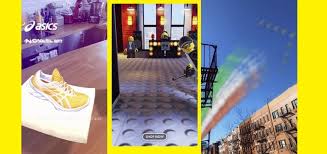Like all social platforms, Snapchat has seen a significant increase in usage amid the COVID-19 lockdowns, but more specifically, Snap has seen a big jump in AR usage. According to Snapchat, over 75% of its users engage with its various AR tools every day, on average, and that’s increased even more in March, as people look for alternative ways to engage with the outside world – even virtually.
Snapchat says that it saw a 37% increase in Snaps sent using an AR Lens during late March, compared to late February. And that’s also lead to the expanded potential for brands – Snapchat additionally notes that:
- Playtime with Sponsored Lens AR experiences has increased by 18% as the COVID-19 crisis has developed
- Lens swipe up rate with Sponsored Lenses has increased by 22% during late March
Sponsored Lenses, which are now easier to create than ever due to the recent release of Snap’s ‘Lens Web Builder’ tool, can be a great way to boost your branding, and with the increased interaction with AR tools during COVID-19, the potential here is significant.
Could AR Lenses be an option for your campaigns?
Providing more perspective, Snapchat has also provided five tips on how to create more effective, engaging AR experiences, some of which are relatively obvious, but may help to frame your own potential AR approach.
1. Create an experience that entertains, educates or inspires
I mean, this is pretty common content strategy advice, right? You need to create content that’s engaging, so it has to entertain, educate or inspire in some capacity, or it’ll fall flat.
In the case of AR experiences, the variation here is that you need to think beyond novelty and consider what your AR experience adds to the users’ perspective. Maximizing your potential in this capacity can be a little more difficult to do with a DIY tool like Lens Web Builder, as it utilizes pre-existing templates. But by considering the experience, and how AR can expand your campaign messaging – as opposed to merely complementing it – you may be able to create more immersive, involving virtual tools that bring something extra, which only AR can provide.
2. Empower Snapchatters to express their emotions
Snapchat notes that at present:
“AR Lenses that empower Snapchatters to communicate with a full range of emotions are resonating more than ever because it easily enables our community to share advice, and send love and support to close friends all over the world.”
This may be particularly true in the current setting, but it’s worth considering at all times – building an emotional connection is key to resonant content, and considering how AR tools can enable such is another way to use the more immersive experience of AR to broaden your brand messaging.
What’s your brand purpose, or the core value of your product? What problems does it solve? How does it make people’s lives better?
Addressing these questions could lead you to a more expressive way to communicate your key message via AR tools.
3. Drive trial by bringing your product to Snapchatters
This is probably the most interesting consideration for AR – with expanding AR capacity, we’re getting to a point where people can viably use these tools to get a better real-world perspective on products that they’re interested in, without having to visit a physical store. Which, right now, is obviously a key consideration.
We’ve written before about Snapchat’s evolving AR options, and how their potential advertising and eCommerce usage options are increasing. With more ways to generate engagement around physical products, the use case for Lenses, in a promotional sense, grows exponentially.
Digital effects will never replace physically touching and feeling an object, but through smart use of AR, you can create campaigns, which highlights key elements and boost interest, providing more context for consumers who – based on the stats – are increasingly likely to make a purchase online either way.
4. Transform Snapchatters’ living rooms into a showroom
This is actually similar to the previous point – though it highlights the capacity for the Snap camera to create more wholly immersive experiences, as opposed to focusing on effects within real-world environments.
This is a more advanced usage of Snap’s AR tools, which would require significantly more investment, but there have been some interesting uses of these more immersive, portal-like, whole world AR tools
Could this be the future of AR shopping? Again, it’s a more advanced option. But there’s a lot of potential here.
- Use the tools at your disposal
Snapchat’s final point is essentially to highlight the various options you have to create branded Lens experiences:
- Build your own AR Lens in minutes with Lens Web Builder
- Work with a Certified Lens Partner to help bring your brand message to the world with AR
- Learn how to use Lens Studio and become your own Lens Creator
Again, Lens Web Builder provides a solid DIY option, which, at the least, will give you a better idea of what’s possible with Snap’s Lenses. But more advanced, immersive tools will require outside expertise – which you can connect to via the Snap partner program.
It could be costly, but going on the engagement stats and notes here, it could also be worth it, if you’re looking to connect with Snap’s younger audience.
These are some good notes, and it’s worth considering if/where AR might fit into your digital strategy. Even if you just play around with Lens builder to see what’s possible, it could help provide more understanding – and if you want to reach younger markets, that could be even more important.
